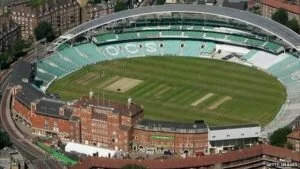1. Lord’s, London
Capacity: 28,000
A respectable listicle about the world’s best cricket stadiums has to start with the Home of Cricket, Lord’s, and this iconic ground gets our top spot. Built in 1814 and named after Thomas Lord, the owner of Marylebone Cricket Club (MCC) at the time, Lord’s is home for Middlesex County Cricket Club, the England and Wales Cricket Board and the European Cricket Council – MCC own and house the Ashes Urn on this hallowed turf. In its 201 year history, there have been more than 100 Test matches played here. Some of the legends of Lord’s include Graham Gooch, the highest Test run scorer at the ground with 2,015 runs, and bowler Ian Botham and his 69 wickets. Although it may be too traditional for some cricket fans, the atmosphere in this ground is truly unique during Test matches, particularly in the morning of the first Test of the summer, before everyone heads to the Lord’s Tavern for lunch and one of their British beef burgers. Even if you’re not the biggest fan of cricket, the architectural features of the stadium are worth a peek: from the Victorian pavilion to the Honours Board, and not forgetting the Old Father Time weather vane, there’s plenty of Instagram action to be had on a tea break.

2. Headingley, Leeds
Capacity: 17,000
Next door to Headingley Rugby Stadium, this is the epicentre of sport in Leeds. Yorkshire County Cricket Club have called Headingly home for more than 120 years and the ground has seen many spectacular sporting moments, including two triple centuries from ‘the Don’ Australia’s Sir Donald Bradman, and Botham’s legendary match-saving performance in the third Test at the Ashes in 1981. Yorkshire can also be proud of their very own Geoffrey Boycott, who scored his 100th century right here. If you think all cricket crowds are mild-mannered and beyond hooting and hollering, think again! Supporters in the Western Terrace would fit in at Wembley during an FA Cup final – well known for their enthusiastic cheering, families are best to sit elsewhere. Although it’s not the prettiest stadium, the club has recently unveiled the ‘Headingley Masterplan’, a huge renovation project to bring permanent floodlight pylons, a rebuild of the North/South Stand to increase capacity to 20,000, plus much more over the next 20 years.
3. Ageas Bowl, Southampton
Capacity: 20,000
Not as old as Lord’s, but every bit as legendary, the Ageas Bowl (formerly the Rose Bowl) was built in 2001 and is the home of Hampshire County Cricket Club. Something of a newbie on the cricket circuit, the stadium has already begun creating a reputation for itself as a regular fixture on England’s white-ball schedule and host of the inaugural Test match against Sri Lanka in 2011. Off the M27 in the leafy Hampshire suburbs of Southampton, it’s a great ground to spend a warm summer’s day sipping ice cold beers in their stylish stands, admiring the perfectly circular pitch. In case you have a few too many, there’s also now a 171-bedroom Hilton hotel, with spa and steak restaurant, just opened at the ground, so you’ve not got far to fall and the end of the day.

4. Edgbaston, Birmingham
Capacity: 25,000
The second biggest cricketing venue in the UK (after Lord’s) Edgbaston is Warwickshire County Club’s turf and is also regularly used for Test matches, One Day Internationals and Twenty20 Internationals. When England comes to play the turnout is terrific; Birmingham’s cricket fans and local Asian communities flock here when India, Pakistan or Sri Lanka show for a match. The stands were packed that legendary day back in 2005 when Edgbaston hosted the epic second Test at the Ashes and England became the first team to hit 400 runs in a first day of Test cricket against Australia since 1938. Another highlight in the ground’s 133 year history is Brian Lara’s world-record first-class score of 501 not out. This classic English cricket ground is moving with the times, installing extra seating for the third Test Match of this year’s Ashes Series. Oh, and there’s great news if you hate rain, Edgbaston is the least disrupted by downpours out of all of England’s Test Grounds, losing less than 90 minutes per play compared with over 8 hours on other pitches.
5. The Oval, London
Capacity: 23,500
Another big-hitter in the south-east of England, The Oval was built in 1845 to house Surrey County Cricket Club and was the first ground to host international Test cricket in 1880. It’s also considered the birthplace of the Ashes, as it was after a game played here against Australia in 1882, which they won by seven runs within two days, that a sports newspaper printed a mock-obituary for English cricket, leading to the creation of the Ashes urn. With such a long and rich history in Test cricket, the atmosphere here on major Test match days is something to be relished: gates open at 4:30 pm and close of play is scheduled for 9:30 pm, between which times the Pimms pours from the bar next to Hobbs Gates and hungry fans ravish greasy parcels of fish and chips or pulled pork rolls. Floodlights were only recently installed, but the original gas-lamps that used to light late play still stand – the Oval was the first sports arena to acquire such lamps in 1889.






